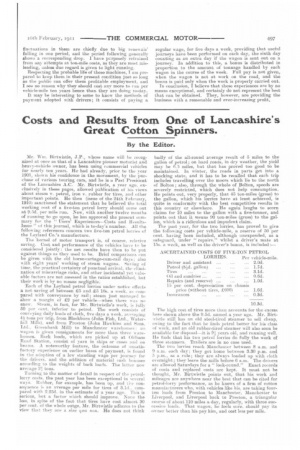Costs and Results from One of Lancashire's Great Cotton Spinners.
Page 17

If you've noticed an error in this article please click here to report it so we can fix it.
By the Editor.
Mr. Win. Birtwistle, J.P., whose name will he recognized at once as that of a Lancashire pioneer motorist and heavy-vehicle owner, has been using commercial vehicles
for nearlyten years. He had already, prior to the year 1901, shown his confidence in the movement, by the pur chase of various touring cars, and he is a Past President of the Lancashire A.C. • Mr. Birtwieele, a year ago, exclusively in these pages, allowed publication of his views about steam v. petrol, iron v. rubber for tires, and other important points. He then (issue of the 24th. February, 1910) sanctioned the statement that he believed the total working cost of a five-ton petrol lorry should come out at 9,5d. per mile run. Now, with another twelve months of running to go upon, he has approved the present eummary for the " Users' Experiences—Costs and ResultsIssue " of this journal, which is to-day's number. All The following references concern two five-ton petrol -lorries of the Leyland Co.'s manufacture.
The kernel of motor trensport is, of course, relarive savieg. Cost and performance of the vehicles have to be considered jointly: the net results have then to be put against things as they used to he. Brief comparisons ran ho given with the old horse-cartage-cum-rail days; also with eight years' working of steam wagons. Saving of time, the practical certainty of punctual arrival, the elimination of miscarriage risks, andother incidental yet valuable factors are not assessed in the ratios established, but their work is by no means negligible:
Each of the Leyland petrol lorries under notice effects a net -saving of between £5 and £5 10e. a week. ne eorapared with conveyance by rail; steam just managed to show a margin of £2 per vehicle—when there was no snow. Steam, in fact, for Mr. Birtwistle's work, is fully 50 per eent. inferior to petrol. The work consists of conveying daily loads of cloth, five days a week, Traging 44 tons per trip, from Blackburn (John Fish, Ltds, Waterfall Mills), and from Preston (John Hawkins and Sons, Ltd., Greenbank Mill) to Manchester warehouses :no wegon is given consignments for more than three e arehouses. Back loads, which are picked up at Oldham Pond Station, consist of yarn in skips or cases find on beams. A noteworthy feature, the outcome of unsatisfactory experience on earlier bases of payment, is found in the adoption of a low standing wage per journey for the drivers, and the addition of material cash bonuses according to the weights of back loads. The latter now average 2:l tons.
Turning to the matter of detail in respect of the petrollorry eoste, the past year has been exceptional in several ways. Rubber, for example, has been up, and the consequence is an average per mile for tires of 3.1d., compared with 2.25d. in the estimate of a year ago. This is serious, but a factor winch should improve. None the less, in spite of the fact that tires have cost almost 30 per cent, of the whole outgo, Mr. Birtwistle adheres to the view that they are a sine qua non. He does not think badly of the all-round average result of 5 miles to the gallon of petrol; on hard roads, in dry weather, the yield may be 6.5 miles, but that has proved too good to he maintained. In winter, the roads in parts get into a shocking state, and it has to be recalled that each trip includes travelling over the moors which lie to the north of Bolton ; also, through the whole of Bolton, speeds are severely restricted, which does not help consumption. He points out, very properly, that 45 ton-miles (gross) to the gallon, which his lorries have at least achieved, is quite in conformity with the best competitive results in this country or elsewhere. He again laughs to scorn claims for 10 miles to the gallon with a five-tonner, and points out that it Inearie 90 ton-miles (gross) to the gal ion, which is a ridiculous and impudent claim.
The past year, for the two lorries, has proved to give the following costs per vehicle-mile, a reserve of 50 per cent. having been included, although unexpended, as a safeguard, under "repairs," whilst a driver's mate at 15s. a week, as well as the driver's bonus, is included :— The high cost of tires more than accounts for the excess here shown above the 9.5d. named a year ago. Mr. Birtwistle still has an old steel-tired steamer to sell cheap, owing to the fact that he lind,s petrol better for his class of work, and an old rubber-tired steamer will also soon he available for disposal—it is 9; years old, and running well. He finds that his two petrol lorries do fully the work of three steamers. Trailers are in no case used.
The two lorries retteh Manchester between 8 a.m. and 9 a.m. each day; they get home between 3.30 p.m. and .5 p.m., as a rule; they are always loaded up with cloth overnight ; they leave the mills before 6 a.m. The drivers are allowed Saturdays for a "look-round," Exact records of costs and replaced •costs arc kept. It must not be thought, Mr. Birtwiethe points out, that his work and mileages are anywhere near the best that can be cited for petrol-lorry performanoe, as he knows of a firm of cotton manufacturers who, with vehicles like his, are taking fourton loads from Preston to Manchester, Manchester to Liverpool, and Liverpool back to Preston, a triangular course of about 110 miles a day, regularly, with three sueccesive loads. That wagon, he feels sure, should pay its owner better than his pay him, and cost less per mile.




































